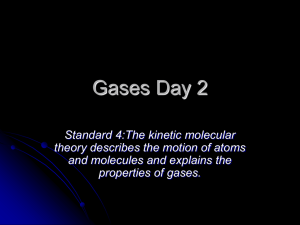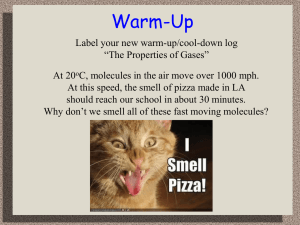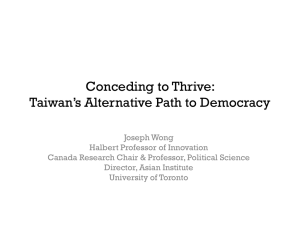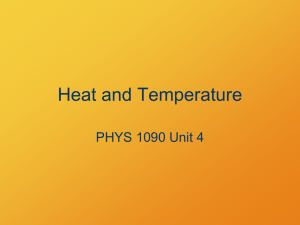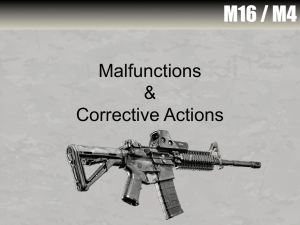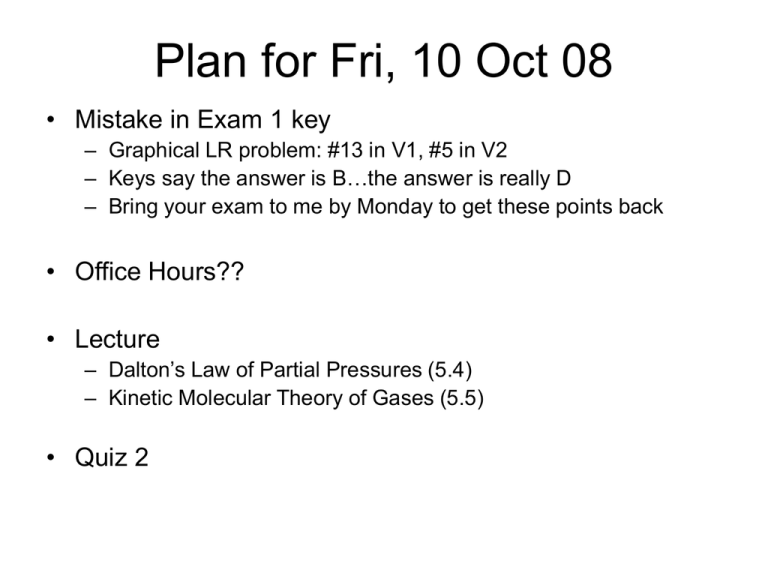
Plan for Fri, 10 Oct 08
• Mistake in Exam 1 key
– Graphical LR problem: #13 in V1, #5 in V2
– Keys say the answer is B…the answer is really D
– Bring your exam to me by Monday to get these points back
• Office Hours??
• Lecture
– Dalton’s Law of Partial Pressures (5.4)
– Kinetic Molecular Theory of Gases (5.5)
• Quiz 2
Three 3.0-L flasks, each at a pressure of 878
mmHg, are in a room. The flasks contain He, Ar,
and Xe, respectively.
•
Which of the three flasks contain the most atoms of
gas?
–
•
Which of the flasks has the greatest density of gas?
–
•
The gas with the greatest M, Xe.
If the He flask was heated and the Ar flask cooled,
which of the three flasks would be at the highest
pressure?
–
•
All flasks contain the same number of atoms.
The flask that was heated, He.
If the temperature of the He was lowered with the Xe
was raised, which of the three flasks would have the
greatest number of moles of gas?
–
They will all have the same number of moles.
Partial Pressures
The pressure exerted on the shelves
by all of the records is equal to the
sum of the pressures exerted by the
individual records:
Ptotal = PABBA +
+ PZZ Top
= Pindividual records
…or the pressures exerted by each
genre:
Ptotal = Prock & roll
P
P
pop
no wave
P
rap
P
P
+
jazz
post-punk
Dalton’s Law of Partial Pressures
For a mixture of ideal gases in a container, the total pressure
exerted by the mixture is the sum of the pressures each gas would
exert if it were alone.
Recall that according to the ideal gas law, gas molecules are
indistinguishable, non-interacting point particles.
Increasing the number of point particles increases the pressure an
amount proportional to the number of moles.
Proving Dalton’s Law
Say we have a container
with some amount of three
different gases inside, at a
certain T and P.
n total = n1 + n 2 + n3
Dalton’s Law says that the
total pressure exerted by the
three gases is the sum of
the individual pressures.
Ptotal = P1 + P2 + P3
Ptotal = P1 + P2 + P3
Ptotal
n 3 RT
n1RT
n 2 RT
=
+
+
V
V
V
Ptotal V = n1RT + n 2RT + n3RT
Ptotal V = n1 + n2 + n3 RT
Ptotal V = n total RT
Example 5.15, p. 195
• Mixtures of He and O2 are used in scuba
tanks to help prevent “the bends.” For a
particular dive, 46 L of O2 at 25oC and 1.0
atm was pumped along with 12 L of He at
25oC and 1.0 atm into a 5.0-L tank. What
is the partial pressure of each gas? What
is the total pressure?
Mole Fraction and Partial Pressure
• In the last example, we determined the total
pressure in two ways:
– We calculated the partial pressure of each gas and
added them together.
– We added up the total number of moles of gas and
then calculated the total pressure.
These two methods suggest a useful
relationship between number of moles of
each gas and total pressure.
Mole Fraction and Partial Pressure
Mole Fraction (): the ratio of the
number of moles of a given
component in a mixture to the total
number of moles in the mixture.
ni
i
ntotal
n1
n1
1
ntotal n1 n2 n3
V
Pi
Pi
RT
Ptotal
V
Ptotal
RT
Pi i Ptotal
The fraction of moles of a certain gas in a mixture is
equal to the ratio of its partial pressure to the total
pressure of the mixture.
Collecting gases over water
E&G, Fig 5.20
Kinetic Molecular Theory (KMT)
• The gas laws of Boyle, Charles, and Avogadro are empirical,
meaning they are based on observation.
– Some guy sitting in a lab and watching how containers full of gases
react to different conditions.
• These laws offer a general description of behavior based on many
experiments.
– They can tell you what happens to an ideal gas under certain
conditions, but not why it happens.
• KMT is a theoretical, molecular-level model of ideal gases, which
can be used to predict the behavior of a gaseous system.
• Since all matter is composed of atoms an molecules, we want to
explain macroscopic behavior in terms of these basic building
blocks.
KMT Postulates
1.
Gas particles are so small compared to the distances
between them that the volume of the individual
particles is negligible.
2.
Gas particles are in constant motion. The collisions of
the particles with the walls of the container are the
cause of the pressure exerted by the gas.
3.
The particles are assumed to exert no forces on each
other; they neither attract or repel their neighbors.
4.
The average kinetic energy of a collection of gas
particles is assumed to be directly proportional to the
Kelvin temperature of the gas.
What can KMT do for you?
• The main ideas you should take from KMT is
that we can describe T and P from a molecular
perspective.
• Pressure: arises from molecules banging into
the container walls.
• Temperature: arises from the kinetic energy of
the gas molecules. The more KE they have, the
faster they can move around, the “hotter” they
are.
Pressure according to KMT
One molecule
Many molecules
Go to Slide Show View (press F5) to play the video or animation. (To exit, press Esc.)
This media requires PowerPoint® 2000 (or newer) and the Macromedia Flash Player (7 or higher).
[To delete this message, click inside the box, click the border of the box, and then press delete.]
Copyright © Houghton Mifflin Company. All rights reserved.
Microscopic Illustration of Boyle's Law
According to KMT, gas pressure is the result of the gaseous molecules colliding
with the walls of the container.
BOYLE’S LAW: As the volume of a gas is decreased, gas molecules have less
distance to travel before they collide with the container, so they collide more often,
and the pressure of the system increases.
n, T constant
1
P nRT
V
constant
as V , P
Go to Slide Show View (press F5) to play the video or animation. (To exit, press Esc.)
This media requires PowerPoint® 2000 (or newer) and the Macromedia Flash Player (7 or higher).
[To delete this message, click inside the box, click the border of the box, and then press delete.]
Copyright © Houghton Mifflin Company. All rights reserved.
Temperature according to KMT
Kinetic energy: The
energy an object has by
virtue of its motion.
Basically, the energy you
must apply to an object
to accelerate it from rest
to a given velocity (u):
Ek 12 mu2
The average Ek of a molecule
is directly proportional to the
absolute temperature in K.
Go to Slide Show View (press F5) to play the video or animation. (To exit, press Esc.)
This media requires PowerPoint® 2000 (or newer) and the Macromedia Flash Player (7 or higher).
[To delete this message, click inside the box, click the border of the box, and then press delete.]
Copyright © Houghton Mifflin Company. All rights reserved.
Microscopic Illustration of Charles' Law
According to KMT, the temperature of a gaseous system arises from the kinetic
energy (Ek) of the gas molecules.
CHARLES’S LAW: As heat is applied, Ek of the gas molecules increases, thereby
increasing their speed. To maintain constant pressure under these conditions, the
volume of the system must increase.
n, P constant
nR
V
T
P
constant
as T , P
Go to Slide Show View (press F5) to play the video or animation. (To exit, press Esc.)
This media requires PowerPoint® 2000 (or newer) and the Macromedia Flash Player (7 or higher).
[To delete this message, click inside the box, click the border of the box, and then press delete.]
Copyright © Houghton Mifflin Company. All rights reserved.
Interplay of T & P according to KMT
According to KMT, gas pressure is the result of the gaseous molecules colliding
with the walls of the container. If the kinetic energy of the molecules is increased,
the molecules will collide more often and more forcefully, thereby increasing the
pressure.
n, V constant
nR
P
T
V
constant
as T , P

